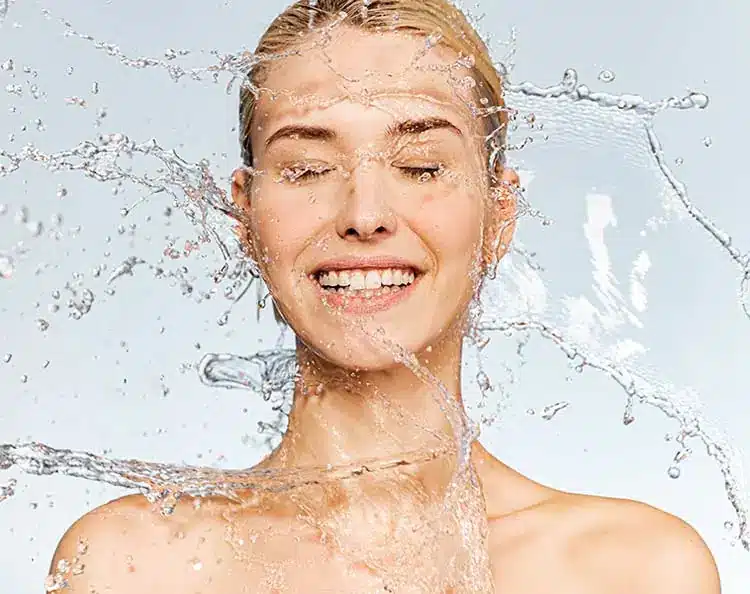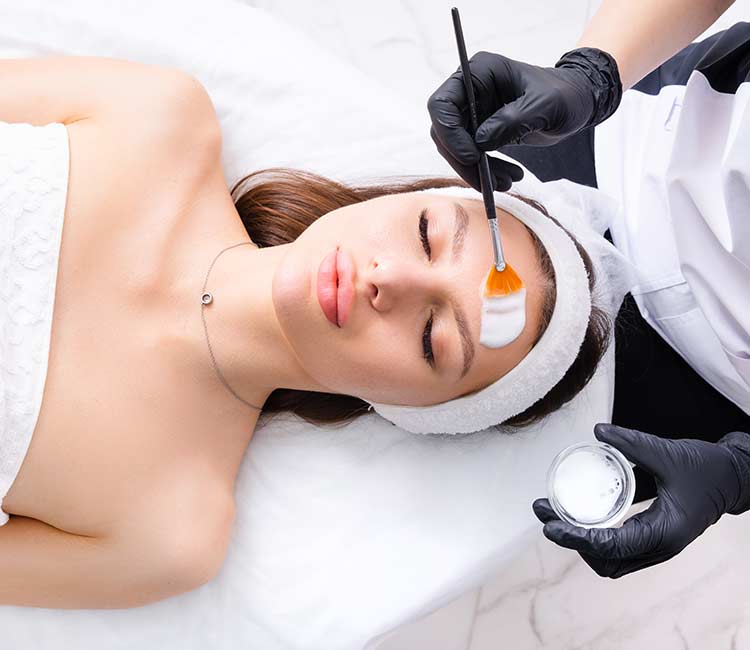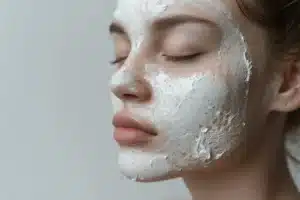Le peeling au rétinol est l’un des traitements esthétiques les plus prisés pour redonner éclat et jeunesse à la peau. Ce peeling chimique utilise une forme de vitamine A (ou rétinol) pour exfolier la peau. Contrairement aux peelings classiques à base d’acides, le rétinol agit en stimulant la synthèse cutanée ce qui permet d’obtenir une peau plus lisse, plus lumineuse et plus uniforme. Ce peeling est particulièrement apprécié pour son action douce mais efficace, qui donne des résultats visibles sans provoquer de desquamation excessive.
Le peeling au rétinol est un soin idéal pour les patients qui souhaitent rajeunir leur peau tout en traitant divers problèmes cutanés. Ce traitement est sûr, efficace et offre des résultats visibles rapidement, sous réserve de respecter les consignes données avant et après la séance.
instructions are carefully followed. If you'd like to learn more or determine whether this peel is right for your skin, a personalized consultation is highly recommended.

Opter pour un peeling au rétinol présente de nombreux avantages :
• Action douce : contrairement aux peelings plus agressifs, le rétinol agit en douceur, il ne cause pas d’irritations ni de rougeurs importantes.
• Résultats visibles dès la première séance : la peau est plus lumineuse et plus lisse en quelques jours.
• Amélioration progressive : les bienfaits continuent à se voir au fil des semaines, grâce à la stimulation de la production de collagène.
• Réalisation possible sur différents types de peaux : le peeling au rétinol convient aussi bien aux peaux sensibles qu’aux peaux grasses ou matures et peut être réalisé sur tout phototype.
Ce traitement est idéal pour les patients qui veulent revitaliser leur peau sans avoir recours à des méthodes invasives.
The retinol peel can be performed year-round. However, it is best scheduled during seasons with limited sun exposure—fall and winter are ideal. Retinol increases the skin’s sensitivity to UV rays, so daily sun protection is essential after the treatment, no matter the time of year.

Le peeling au rétinol utilisé par le docteur Romano est un peeling superficiel adapté à la plupart des types de peaux. Ce peeling convient aussi bien aux peaux jeunes souhaitant prévenir les signes du vieillissement qu’aux peaux plus matures cherchant à corriger les imperfections liées à l’âge.
The indications are :
• Wrinkles and fine lines : le peeling au rétinol atténue les signes du vieillissement cutané.
• Teint terne : le peeling au rétinol redonne de l’éclat aux peaux fatiguées.
• pigmentations pigmentaires : le peeling au rétinol aide à atténuer les taches dues au soleil ou au vieillissement.
• Acné : le peeling au rétinol réduit les lésions inflammatoires d’acné et prévient les éruptions futures.
• Pores dilatés : le peeling au rétinol aide à affiner le grain de peau et à resserrer les pores.
Ce peeling est indiqué pour le face mais il est possible de le réaliser sur d’autres parties du corps comme le neck, facial décolleté, les seins, les épaules, le dos, les hands and pieds.

La séance de peeling est précédée par une consultation pendant laquelle le docteur Romano vérifie les antécédents médicaux du patient et analyse sa peau.
La peau du patient est nettoyée pour éliminer toutes traces de maquillage. Le Pre-Peel est appliqué à l’aide d’un coton ou d’une compresse pour éliminer le sébum restant et équilibrer le PH.
De la vaseline est appliquée à l’aide d’un coton-tige sur toute coupure ou abrasion, piercing, lèvres supérieure et inférieure, plis de la bouche et du nez, coins des yeux, et autres zones où la solution peeling peut s’accumuler afin de les protéger au cours de la procédure.
Le produit est appliqué uniformément sur la zone à traiter : une couche sera appliquée pour un peeling léger, plusieurs couches pour un peeling plus intense.
Pendant 10 minutes environ, le docteur Romano observe la peau pour détecter des signes d’érythème et demande au patient s’il ressent un inconfort. Dans ces cas le docteur rince le peeling.
Après 10 minutes, et si le peeling est bien toléré, le docteur masse pour faire pénétrer l’excédent de produit. La neutralisation n’est pas nécessaire.
Le patient rincera le peeling 8 heures plus tard ou le lendemain. En cas d’irritation, le peeling peut être enlevé plus tôt.
Pour les peaux sensibles et si le patient souhaite un effet d’exfoliation réduit, il peut rincer le peeling après 3h.

Avant de procéder au peeling, certaines précautions doivent être prises pour garantir une efficacité optimale et éviter la survenue d’effets secondaires.
• Éviter une exposition solaire excessive les jours précédant la séance.
• Suspendre les traitements irritants : si vous utilisez des acides exfoliants ou des produits à base de rétinoïdes, leur arrêt soit se faire une semaine avant le traitement.
• Bien hydrater la peau : une bonne hydratation de la peau avant la séance permet d’optimiser les résultats.
Le docteur Romano vous donnera ultérieurs recommandations spécifiques en fonction de votre peau.
Après la séance, il est important de suivre certaines consignes pour accélérer la cicatrisation et éviter la survenue de complications.
• Appliquer la crème hydratante plusieurs fois par jour, le docteur Romano vous en conseillera une.
• Utiliser une protection solaire à large spectre avec un indice élevé (SPF 50) quotidiennement.
• Éviter l’exposition directe au soleil pendant plusieurs jours après le traitement.
• Ne pas exfolier la peau ni utiliser de produits irritants pendant au moins un mois après la séance.
• Éviter l’épilation au niveau du visage, la décoloration, la permanente ou le lissage des cheveux, la luminothérapie, les traitements lasers et la lumière pulsée jusqu’à réparation complète de la peau. Il faudra attendre un mois environ.
• Il ne faut pas retirer, érafler ou gratter la peau.
• Idéalement, il faut éviter de fumer pendant une semaine.

Bien que le peeling au rétinol soit généralement sûr, certaines contre-indications doivent être respectées.
• Pregnancy and breastfeeding.
• Allergie aux dérivés de la vitamine A.
• Peaux irritées ou lésées : il faudra attendre la guérison complète de la peau avant d’envisager ce traitement.
• Présence de verrues sur la zone à traiter à cause d’une éventuelle propagation du virus.
• Prise de certains traitements ou procédures qui sensibilisent la peau, comme les gommages.
• Prise d’anticoagulants ou d’immunosuppresseurs.
• Arrêter la prise de rétinoïdes oraux 6 mois avant la séance de peeling et l’utilisation de rétinoïdes topiques et exfoliants 1 à 2 semaines auparavant.
Possible reactions following a retinol peel include :
redness (erythema), peeling, sensitivity, tingling, itching, burning sensation, tightness, mild inflammation, and increased sun sensitivity.
Mild peeling may occur 2 to 3 days after the procedure and can last for about a week. These reactions generally subside gradually within a few days.
Superficial peels may also cause perioral dermatitis, acne flare-ups, or herpes outbreaks. This is why preventive antiviral treatment is prescribed in patients with a history of Herpes simplex infection.
Some patients may develop hyperpigmentation (dark spots) or hypopigmentation (light spots), which usually resolve within a few months.
Les résultats du peeling au rétinol sont visibles après quelques jours seulement. Dès la première semaine, la peau est plus lisse, plus éclatante et les imperfections cutanées sont atténuées. Au fil des semaines, les bienfaits se renforcent, notamment grâce à l’augmentation de la production de collagène stimulée par le rétinol. Les rides et les ridules s’estompent progressivement, les taches pigmentaires s’éclaircissent et le grain de peau devient plus uniforme. La peau est plus dense et moins relâchée.
Il faut plusieurs séances pour obtenir des résultats optimaux. Les résultats peuvent varier en fonction de chaque personne, mais la majorité des patients constatent une amélioration notable de la qualité de leur peau après 2 à 3 séances.
Les peelings sont réalisés à intervalles de 6 à 8 semaines, à condition que la peau soit complètement cicatrisée. Si cela n’est pas le cas, l’intervalle entre deux séances est de 10-12 semaines ou plus si nécessaire.
The retinol peel is offered at a price of 300 CHF per session. This rate includes the medical procedure, skin preparation, and the controlled application of the product by Dr. Romano. It is a specific procedure requiring particular expertise. No surcharge is applied based on phototype or skin sensitivity.
Le peeling au rétinol recueille des avis très positifs de la part des patients. Beaucoup apprécient la douceur du traitement, qui permet d’obtenir des résultats visibles sans les inconvénients d’un peeling agressif. Les patients notent une amélioration de la qualité de leur peau, avec un teint plus éclatant et un grain de peau affiné. Les patients ayant des cicatrices d’acné ou des rides légères remarquent également une amélioration de ces imperfections.
Les patients aiment également le fait que ce peeling ne cause pas d’éviction sociale. Bien que des rougeurs et une légère desquamation puissent apparaître, ces effets secondaires sont généralement gérables et disparaissent en quelques jours.
Oui, le peeling au rétinol est reconnu pour son efficacité. Il stimule le renouvellement cellulaire, affine le grain de peau, réduit les imperfections et améliore l’éclat du teint. Il est également apprécié pour atténuer les signes de l’âge et uniformiser la peau.
Retinol is not recommended during pregnancy, breastfeeding, or when the skin is irritated or damaged. It should also be avoided during periods of intense sun exposure, as it increases skin sensitivity to UV rays.
Oui, le peeling au rétinol est efficace pour atténuer les taches pigmentaires, qu’elles soient liées au soleil, au vieillissement ou à des troubles hormonaux. Il permet d’avoir une peau plus uniforme et lumineuse.
Le peeling au rétinol contribue à réduire les ridules et les rides en stimulant la production de collagène et en accélérant le renouvellement des cellules cutanées. Il améliore ainsi la fermeté et la qualité de la peau.
An effective peel results in smoother skin, a brighter complexion, and visibly reduced imperfections after a few days of peeling. Optimal results are usually seen after several sessions, depending on the treatment plan.
Oui, le peeling au rétinol peut convenir à tous les types de peau, mais il est essentiel d’adapter la concentration et la fréquence selon la sensibilité cutanée. Une évaluation préalable par un médecin doit être réalisée.
Recovery typically lasts between 5 and 7 days. During this time, the skin may show redness, peeling, and a slight feeling of tightness.
Il est fortement déconseillé de s’exposer au soleil après un peeling au rétinol, car la peau est temporairement plus sensible aux UV. Il est essentiel d’appliquer une protection solaire SPF 50 et de privilégier les zones ombragées durant toute la phase de cicatrisation.